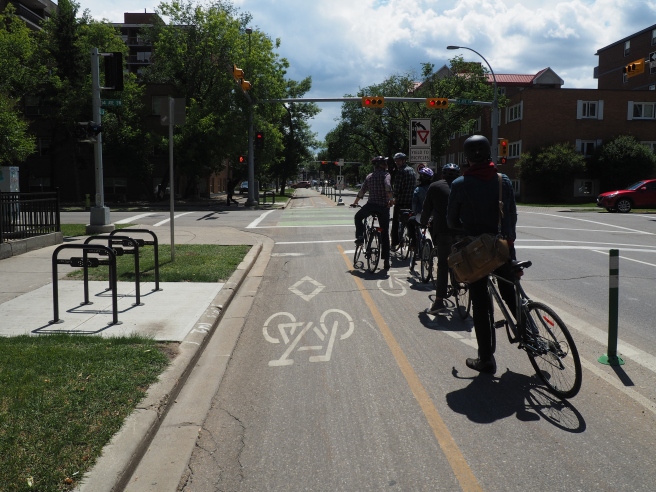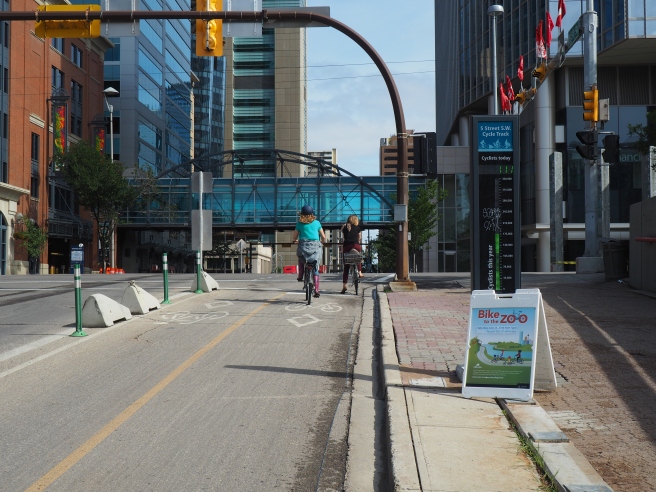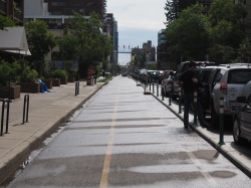
Calgary’s pilot network of protected bike lanes is an excellent example of bicycle infrastructure done along the quicker, lighter and cost effective frame of mind. Taking a results-oriented approach with a minimal implementation to create a safe and comfortable cycling environment for all ages and abilities. While lighter, quicker and cost effective cycle lanes like this have already been implemented in places like Chicago, Washington D.C. and Seattle, what is unique to Calgary’s network is that it was implemented all at once. No piecemeal approach, rolling out each bike lane one at a time over years.

While the story of how the city managed to implement this in a car dominated city is no small feat. That being said the network is a runaway success, after one year the bicycle network has seen over 770,000 trips. The busiest section (5th Street) is seeing 2,400 people cycling per day. For a city with only a 1.3% (2011) cycle to work rate, this is impressive. To put this into perspective Vancouver is currently seeing 6,000 people per day on the Seawall (Vancouver potentially has a 10% bike to work rate now). In addition to this the network is attracting more women and children, which is an indicator that people feel that it isn’t just for the confident, strong and brave. The volume of women cycling has went up 25%, from accounting for 1 in 5, to 1 in 4 of every person cycling.
Why a Network?

While a single protected bike lane does make an improvement, it only connects destinations along that corridor and only in that direction. A network maximizes the usefulness of cycling. Connecting more potential origins and destinations all at once, makes it more likely that it will suit someone’s particular shopping or commuting trip by cycling.
Key Elements


This 7 km success story was created through a combination of paint, plastic bollards, concrete barriers, curbs, planters, parking and cycling signal lights. Based on seeing the Calgary cycle tracks in action, it is similar to the bike lanes in New York City on 1st Avenue.
The vast majority of vehicle collisions with people cycling occur at the intersection. The Calgary cycle track is effective with its resources since it brings protection right up to intersection cross walk with hard surfaces that driver’s are afraid to hit (usually concrete gravity barriers, or planters). In the event that a car does hit the hard surface at the intersection, the heft will stop the car and protect anyone cycling.
The mid-block sections were usually protected with either small modular curbs, plastic bollards and parking. This is sufficient to keep cars out of the bike lane. The fear of mixing with traffic while cycling is one of the main deterrents for the approximately 40% that are interested but concerned about starting cycling. Since many of Calgary’s downtown streets are one way, introducing phased signal lights to control vehicle turning movements additionally improve cycling safety.
There are different types of bike lanes too, bidirectional, unidirectional and even a shared street. On 5th Street and 12th Avenue the lanes are bidirectional with extra room for the door zone and unloading for parked cars.
The design isn’t perfect, and needs some improvements at the mixing zones and intersections. However, for a meager $5 Million this is a heavy lifting people mover (accommodating 770,000 trips over one year). The intent of such a design is to implement it quickly so that it is safe, convenient and comfortable to use rather than waiting for the perfect funding, plan or resources. These bike lanes are ready to use now, and when the resources become available they can be improved with high quality permanent materials.










